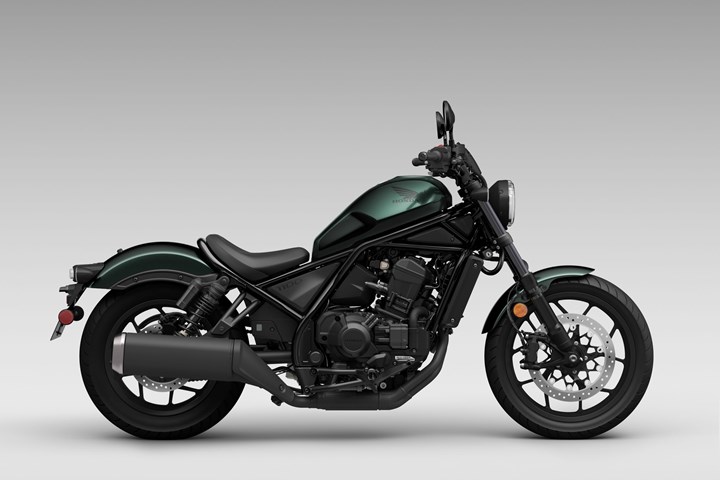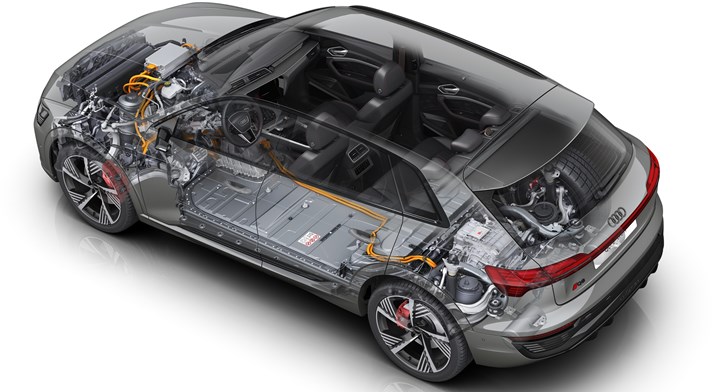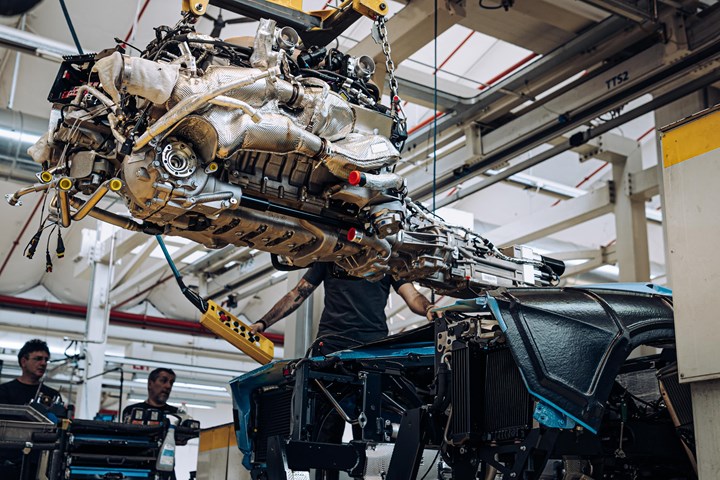on Motorcycles, Environment, EVs, & the End of the Lambo V12
Honda still makes motorcycles. . .motorcycles and guardrails are not a good combo. . .electric bikes in Bali. . .Hyundai head talks environment. . .Audi reintroduces the e-tron. . .Lexus UX review. . .Lambo numbers (minus V12). . .Electrify America & education. . .IONIQ 6 & aero. . .bio-based material for acoustic insulation. . .
Motorcycles Matter

Honda Rebel 1100 DCT. The company makes plenty of motorcycles. And globally, it is really good business. (Image: Honda)
Those of a certain age or advertising enthusiasts will remember that Honda once had a slogan: “You meet the nicest people on a Honda.”
Note the on. It is not in. The nicest people were riding motorcycles. Presumably back in the mid-60s when the slogan was used there was a concern that you’d meet a member of the Hells Angels so it was just providing some assurance.
Plus, Honda wasn’t selling cars in the U.S. until 1969. (The. . .N600.)
Nowadays, it seems, most of the attention on the brand is related to things like the Accord and Pilot.
But Honda still builds motorcycles.
Serious Sales Numbers
In fact, when Honda Motor Co., Ltd. reported its fiscal Q2 last week, it stated a 224.7 billion yen operating profit for its motorcycle business—a year-on-year increase of 51.7%.
Over on the automobile side of the house things were not quite so robust: an operating profit of 63.5 billion yen—a year-on-year decrease of 45.7%.
In the quarter it sold nearly 5 million motorcycles and fewer than a million automobiles.
Last week it announced for the U.S. market “the return of 11 on-road motorcycle models.”
The offerings range from large cruisers to small scooters.
Maybe More Sales
Honda attributed its improved global motorcycle profits to higher sales in Asian markets (and favorable currency). Presumably by putting more bikes on offer in the U.S. market it hopes to gain more traction there.
While the global auto industry is struggling to get better numbers than it achieved in a not-robust 2021, according to MotorCycles Data, two-wheeler global sales during the first nine months of 2022 were 40.5 million units, up 3.7% compared to last year. The firm projects total scooter and motorcycle sales will finish the year at 61.8 million.
///
Motorcycles and Guardrails: Be Careful
This, from the recently published Motorcycle Crashes into Traffic Barriers: Factors Related to Serious and Fatal Injuries (2022):
“In 2018, motorcycle riders accounted for 40% of all fatalities resulting from a guardrail collision. Following motorcycle riders, car occupants accounted for 31% of all fatalities in this crash mode. This is particularly surprising as cars compose approximately half of the vehicle fleet (46%), while motorcycles comprise only 3% of the registered vehicles.”
Also:
“Although this study focused primarily on barrier collisions, other roadside objects also pose a great risk to motorcyclists. This component of the study investigated the national risk of fatality in collisions with trees, signs and poles, guardrails, and concrete barriers.”
All of which is to say: If you ride, be careful. No matter what brand bike you’re on.
///
Bikes in Bali

Nearly 300 Zero electric motorcycles were sourced by the government of Indonesia for the G20 meeting. (Image: Zero Motorcycles)
One more thing about motorcycles. . .
At this week’s G20 Summit in Bali, members of the National Police and the Indonesian National Armed Forces, including the Presidential Security Force, rode full-size electric motorcycles.
Indonesian president Joko Widodo said before the event that he wanted all of the government’s vehicles used for the summit to be zero-emission.
So as part of that mandate nearly 300 motorcycles were ordered from Zero Motorcycles—of Santa Cruz, California.
The bikes are the Zero DSRP model, which are specifically for police forces, and the SR/S and SR/F premium models, which were modified for tactical use.
According to Zero Motorcycles, its fleet-specific models are currently used by more than 240 U.S.-based agencies, as well as many worldwide.
The DSRP, incidentally, has a top speed of 102 mph and a combined range of 91 miles.
Bali is 95 miles wide and 70 miles top to bottom, so that range is undoubtedly more than ample.
///
Hyundai Head on the Environment

Euisun Chung, executive chair of the Hyundai Motor Group, talking about environmental initiatives at the B20 meeting. (Image: Hyundai)
Speaking of the G20. . .
Prior to the G20 the B20 Summit was held in Indonesia.
The B20 participants, private economic groups and business representatives, develop recommendations that they hope will be considered by the governmental representatives at the G20.
One of the keynotes at the B20 was presented at the “Energy, Sustainability & Climate and Finance & Infrastructure” session by Euisun Chung, executive chair of the Hyundai Motor Group.
Realize that according to figures from AutoForecast Solutions, in terms of 2022 global production, Hyundai, with 6,971,479 vehicles, trails only Toyota (10,217,866) and Volkswagen (8,062,073). What that company’s chief has to say about global transportation matters.
Some of Chung’s observations are worth considering:
- “The fact is that the world is facing a climate change crisis. The auto industry is rethinking energy and investing in renewable energy, but it is an endeavor that we cannot pursue alone. With commonsense solutions, government and industry can provide the right incentives to businesses and consumers to embrace clean mobility.” Lesson: Partnerships are essential between business and government.
- “We are pursuing a net-zero strategy across all our value chains, including the purchase of auto parts, vehicle manufacturing, logistics, customer use of our products and vehicle recycling. We need the strong support of global leaders who create policies that encourage investment in these new resources and technologies.” Observation: Given the size of Hyundai Motor, there are plenty of factors involved in trying to orchestrate a net-zero strategy. And the undertaking isn’t inexpensive. So when it comes to government policies, that needs to be taken into account.
- “Governments and businesses must play their part and drive global change. Together, we can set the conditions to accelerate the adoption of eco-friendly solutions.” Bottom line: That pretty much makes the point. One really can’t do it without the other.
///
Audi Identity Issue

The Audi Q8 e-tron: an SUV. An electric flagship SUV. (Image: Audi)
2018 saw the launch of the Audi e-tron, the German company’s first production EV. Audi product planners knew that starting with a SUV EV was the thing to do.
Since then, Audi has sold about 150,000 of the vehicles.
Maybe they figured that because it wasn’t immediately evident to the Audi faithful that an e-tron is an SUV kept it from gaining significantly more traction in the market.
After all, while “e-tron” may intrinsically sound like something electric, that’s as far as it goes.
For the new model the name has been changed to “Q8 e-tron.”
The company had some equity in the Q8 name for its SUV flagship model.
So it appended the alphanumeric to the electric variants (there is also the Q8 Sportback e-tron).
Audi puts it:
“By renaming this model the Q8, Audi is making a clear statement that the Audi Q8 e-tron is the flagship model among its electric SUVs and Coupe SUVs.”
Perhaps that will resolve what is arguably an identity crisis in the market.
However, the company goes on to maintain, “The Audi Q8 e-tron and Q8 Sportback e-tron are immediately identifiable as fully electric models, marked out by the new front and rear designs that carry Audi’s electric design language forward.”
There it might be excessively hopeful. The whole “immediately identifiable as fully electric models” from looking at the front and rear fascias is more than a slight exaggeration.
It was probably that sort of thinking that led Audi marketers to think back in 2018 that prospective customers would immediately know that the e-tron was an electric Q8 by another name.
Designers talk “design language.” Regular people don’t.
///
2023 Lexus UX 250h Sport

Lexus UX. A compact crossover for the urban environment. (Image: Lexus)
Lexus has a full suite of SUVs. They are available in an array of sizes. At the top there is the LX. This full-size behemoth is 200.2 inches long, 78.35 inches wide, 74.21 inches high, and it has a 112.2-inch wheelbase.
At the opposite end is the subcompact UX. It is 176.97 inches long, 72.44 inches wide, 59.84 inches high, and has a 103.94-inch wheelbase.
There are the midsize RX and the compact NX in between, with the GX (another full size smaller than the LX) to boot.
Lexus has something for everyone who is looking for an SUV.
And it seems like everyone is looking for an SUV.
In the City. . .
The 2023 UX 250h—with “h” signifying “hybrid,” and the vehicle is now a hybrid-only model (previously there was a non-hybrid version)—is one of those things that is for the “urban dweller.” Which goes mainly to the point that it is diminutive, relatively speaking (and not just compared to the LX).
The name of the vehicle comes from “Urban + X-over,” with the “X” being pronounced as “cross.”
The vehicle was originally launched in MY 2019. The chief engineer of the vehicle, Chika Kako, had spent time in Europe. In Europe, German flagships notwithstanding, small is a beneficial characteristic (boulevards notwithstanding, there are lots of narrow congested streets in city centers and parking space is at a premium—or maybe that should be “minimum”), as is fuel efficiency (the MY 2023 UX 250h is stickered at 41 mpg city, 38 mpg highway and 39 mpg combined).
Kako said at the time of launch, “I wanted to positively overturn the image of a crossover and offer a car with nimble performance and excellent maneuverability that makes it as easy to drive as a sedan.”
And she succeeded in that, as the vehicle is readily maneuverable (it offers a 17.1-foot turning radius), and although it has a higher H-point than a sedan, it isn’t particularly noticeable that this is something that isn’t a somewhat steroidal sedan. Those who are looking for more of a typical crossover experience would be more well served by the larger, compact NX.
Motors, Materials & More
The UX 250h AWD is powered by a 2.0-liter Atkinson cycle four that is mated to a two motor-generator hybrid transmission (both permanent magnet motors) and because this is an AWD vehicle there is a third motor-generator in the rear (an induction motor).
All in, the total system horsepower is 181.
To make the vehicle light so as to be more lithe, the doors, hood and front fenders are aluminum; the rear hatch is made with both polymer and aluminum. (Curb weight for the AWD version: 3,605 pounds.)
The vehicle as-driven has the F SPORT Handling package. While this means differences in things like sport seats (eight-way power adjustable) and pedals made with aluminum; the Handling addition provides performance dampers and the Active Variable Suspension system that is meant to improve steering response and provide better handling. That said, this won’t be mistaken for being a pocket rocket.
Most notable on the interior is a 12.3-inch touchscreen display for all manner of infotainment applications. With Drive Connect, there is “Hey Lexus” intelligent assistance. And, of course, there is the characteristic Lexus attention to materials and how those materials come together.
There is also Lexus Safety System+ 2.5, which offers an array of functions including pre-collision system with pedestrian detection (radar and camera sensors may cause the braking to kick in in order to mitigate or avoid a collision with objects ranging from vehicles to people), road sign assist, and much more.
Styling
Lexus exterior styling of late has been controversial, which is a good thing because nowadays vanilla doesn’t sell. While the criticism has largely focused on the grilles, and, yes, the UX has a proportionately large grille, I am personally not troubled by the grille design. One of the things that I do find a bit off-putting is the cladding that surrounds the wheel openings: that’s something more associated with a vehicle that is the opposite of “urban,” and the UX is not that vehicle.
Sure, the potholes in many urban environments might make you think you’re traversing the Rubicon Trail, but still, that cladding doesn’t do the exterior any favors.
///
A Quick Look at Lambo

A Lamborghini V12 being installed. End of an era for the massive internal combustion engine. (Image: Lamborghini)
Lamborghini announced that the first nine months of 2022 were the best in the company’s history.
It delivered 7,430 vehicles. Globally.
That’s an 8% increase over the first three quarters of 2021.
While it would be absurdly amusing to point out, by contrast, that U.S. sales of the Ford F Series were down for the first three quarters in 2022 by 12.6% compared to the same period in 2021, there were 467,307 units sold.
But that’s just silly.
However, there’s the number of F-150 Lightnings sold in the first three quarters that might be brought into comparison:
8,760.
Yes, more electric trucks than the entire fleet of Lambos.
However, Lamborghini sold 4,834 Urus SUVs which start at $225,500, so there’s that.
Which helped achieve the operating profit of €570 million.
But the real reason behind this is the number 12.
As in V12.
In September Lamborghini produced the last Aventador, the last Lambo to have a V12 engine.
By 2024 Automobili Lamborghini will have a complete range of hybridized vehicles.
So you won’t see a picture like that above coming out of Sant'Agata Bolognese again.
///
Learning About EVs

Electrify America is investing big in education about charging in low-income and disadvantaged communities in California. Charging may appear like pumping gas, but it is more different than it appears. (Image: Electrify America)
Credit to Electrify America, the company that operates and continues to build out an electric vehicle charging network across the country, for announcing that it is adding nearly $3-million to the overall $200 million that it is investing in California through mid-2024 for infrastructure (i.e., charging facilities) and education.
This new commitment is focused on education and awareness among low-income and disadvantaged communities.
Funding will be distributed to four entities:
- Breathe Southern California
- Ecology Action
- Plug In America
- Valley Clean Air Now
“In the exciting race to electrify our transportation system, many communities have not had equitable access to the resources and information that can help establish adoption of electric vehicles”—Gabriela Herrera Gugiu, corporate social responsibility senior specialist, Electrify America.
While this undertaking is certainly laudable—after all, there is probably a sense that people simply know about EVs, including what’s involved in charging—there is one thing that is the proverbial elephant in the room.
A Non-Trivial Problem
According to Kelley Blue Book, in October 2022 the average transaction price for an electric vehicle in the U.S. was $64,249—well beyond the means of low-income individuals and households.
Electrify America can’t change that.
It is up to the vehicle manufacturers to build electric vehicles that are targeted at the mass market. GM’s announcement that its Equinox EV will have an estimated MSRP “starting around $30,000” is a move in the right direction.
But this is something that there needs to be more of. And it isn’t going to be on the market for about a year.
Let’s face it: most middle-income vehicle buyers probably can’t afford $64,249, to say nothing of those with less than that.
With volume comes reduced prices. But that volume probably isn’t going to manifest itself until reduced prices are available in the market.
Chicken? Egg?
Meanwhile, Back in the 19th Century. . .
One more thing. There was a German psychologist named Hermann Ebbinghaus (1850-1909). He came up with a formula that calculated the rate at which information is forgotten.
It is called the “Ebbinghaus Curve.”*
The decline is fairly steep, as much as 90% in the first seven days.
The way the learning can be maintained is by reinforcing it and by having it made relevant to one’s daily existence.
If it take a l-o-n-g time to get EVs in low-income and disadvantaged communities, then there’s a likelihood that what people may have learned about EVs will be forgotten.
*Do you think you’ll remember the Ebbinghaus Curve a week from now?
///
IONIQ 6 Exterior Influences & the Importance of Air

Plenty of attention was paid in making the exterior of the IONIQ 6 electric vehicle slippery in the air. (Image: Hyundai)
Which of these didn’t influence the exterior design of the Hyundai IONIQ 6 electric sedan:
- Scout Scarab
- Phantom Corsair
- Saab Ursaab
- Supermarine Spitfire
- Peregrine falcon
Trick question.
They all did.
- Simon Loasby, Hyundai Head of Styling:
“IONIQ 6 started with a single curve that defines its profile and architecture—the ultimate streamlined form—and ‘Electrified Streamliner’ became the pet name for the car.
“The true beginning of aerodynamic design and engineering started in the 1930s and we felt that taking inspiration from that era—and indeed from nature—was the perfect way to create uniqueness and sustainable performance in the EV segment.”
- Jinhyuck Chang, Hyundai Head of Aerodynamic Development:
“The Spitfire wasn’t the only high flyer on the design team’s radar during IONIQ 6’s development
“They also took notes from nature too, especially the shape that a peregrine falcon takes when it dives after prey at 390 km/h.”
The car has a drag coefficient of 0.21.
The vehicle design was tested in a wind tunnel where a 3,400-hp fan generated wind speeds up to 124 mph, but the engineers also used computational fluid dynamics and a shape transformation technology called the “morphing technique.”
These methods resulted in determining such things as the shape of the rear spoiler and the configuration and location of the active air flap, wheel air curtains, wheel gap reduces, separation traps, and wheel deflectors.
Why all this interest in aero?
- Min Byung-hoon, Hyundai executive vice president and Director of Vehicle Performance Development:
“In the EV era, air resistance is more important than any other performance.”
///
Something to Think About
“Awareness means nothing; relevance means everything.”
--John Waraniak, 2020 SAE Fellow
///
Sometimes That New Car Smell Is a Bit Off (Not Now)

Huntsman has developed a polyurethane foam system with bio materials for acoustic applications that is said to be without the odors that bio-based materials can have. (Image: Huntsman)
“Previously, there was a frustration that incorporating bio-based content into a polyurethane foam system would have a detrimental impact on performance, specifically on emission and odor levels.”
That’s Irina Bolshakova, Global Marketing Lead for Automotive Polyurethanes at Huntsman.
She’s talking about materials used in vehicles to reduce noise and vibration, materials, for example, that would be used under the carpet.
It is certainly laudable to be environmentally oriented, but if the product results in something that makes the consumer bust out with a bottle of Febreze in their new vehicle, that’s not a wholly good thing.
And Now This
Huntsman has developed a new material, ACOUSTIFLEX VEF BIO, that it says can reduce the carbon footprint of a vehicle’s carpet back foaming by up to 25%.
Up to 20% bio-based content, derived from vegetable oils, is used.
The company says the material system is “both low emission and low odor.”
The acoustic properties are there. The weight is the same of the company’s existing ACOUSTIFLEX polyurethane systems.
Other applications for the material are dash and wheel arch insulation.
Presumably, it is nose-neutral.
RELATED CONTENT
-
Flying Car Flight of Fancy Gets Real
People have been dreaming about flying cars since the early days of the auto and aircraft industries.
-
Toyota Employees to Aid Michigan V2X Research
Toyota Motor Corp. is encouraging employees at its research and development center near Ann Arbor, Mich., to participate in an on-going program there to test connected vehicle technologies.
-
On Audi's Paint Colors, the Lexus ES 250, and a Lambo Tractor
From pitching a startup idea to BMW to how ZF is developing and using ADAS tech to a review of the Lexus ES 250 AWD to special info about additive at Toyota R&D. And lots in between.


.jpg;width=70;height=70;mode=crop)






